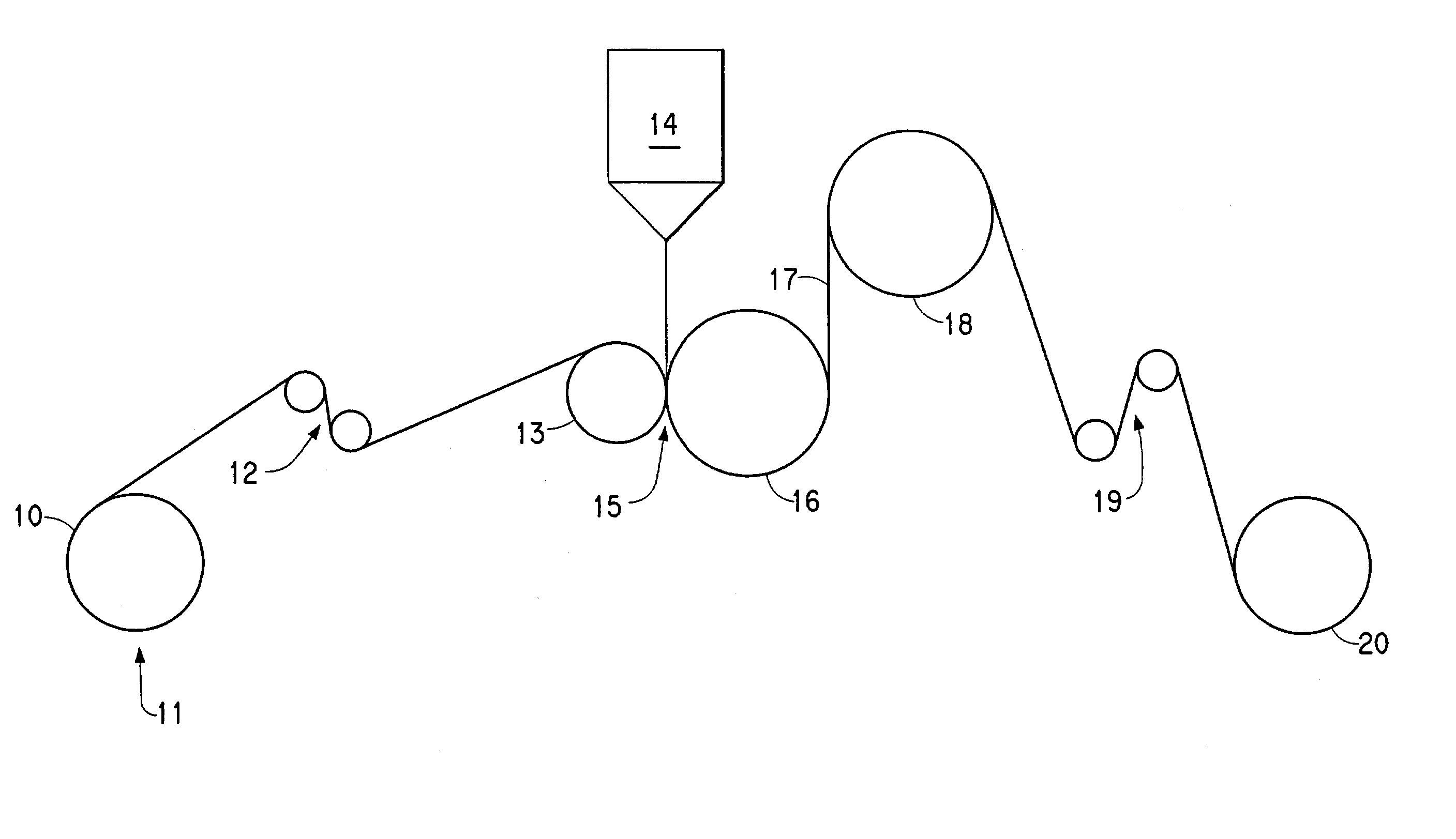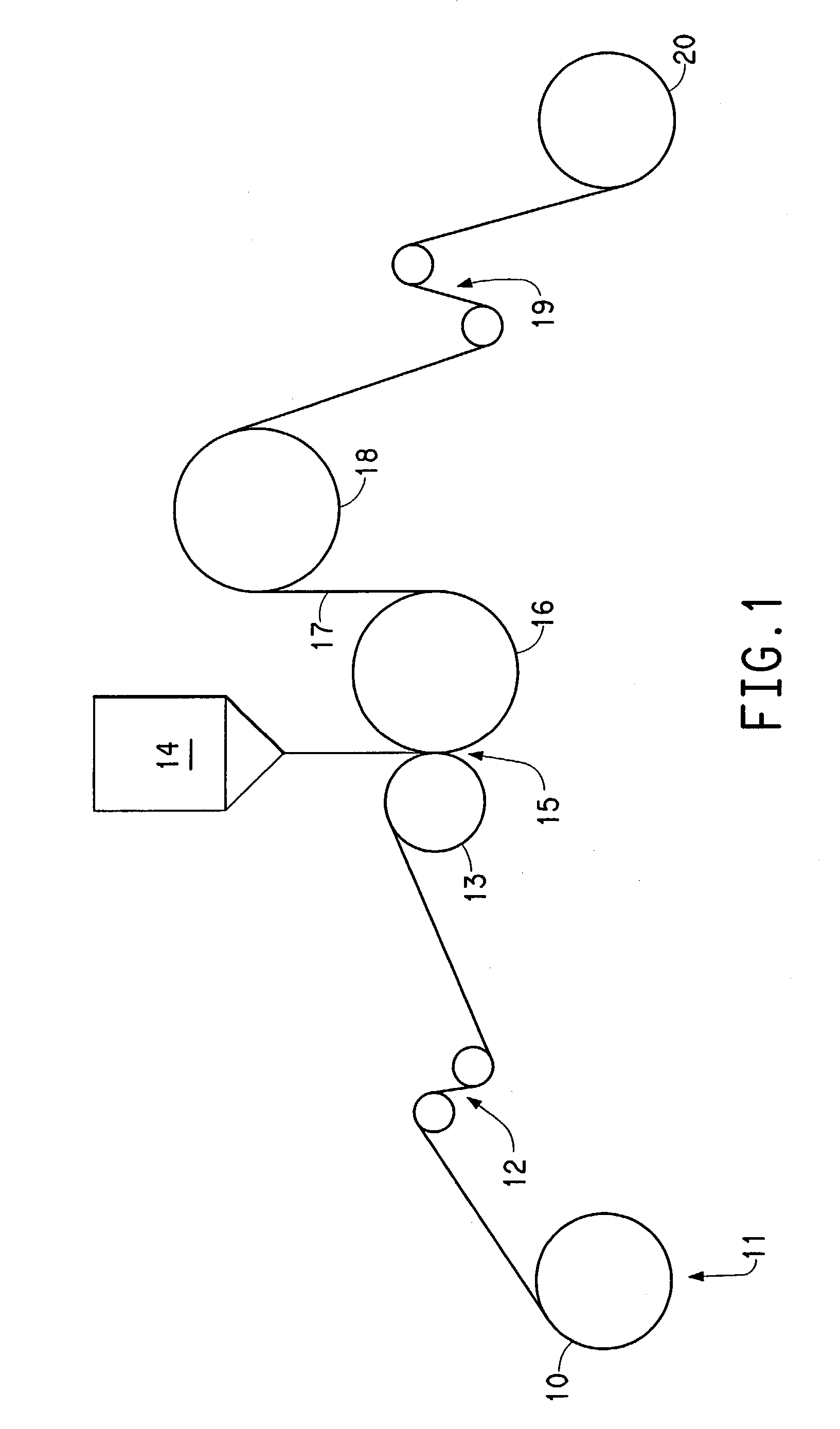Fluoropolymer film structures and laminates produced therefrom
- Summary
- Abstract
- Description
- Claims
- Application Information
AI Technical Summary
Benefits of technology
Problems solved by technology
Method used
Image
Examples
example 1
[0081]The good primer / adhesive bonds provided by the present invention are illustrated by making PVF / primer / adhesive / primer / PVF laminates. This structure allows for the use of lab heat sealing equipment without sticking to the jaws or incorporating some other release layer. In addition, this structure also illustrates the strength of the primer / adhesive interface under varying conditions.
[0082]Cast, corona treated PVF-1 film is primed with an amine functional acrylic polymer (P2) by solvent casting. Thermoplastic adhesive of acid modified polyolefin as indicated in Table 1 below is applied to a first layer of the primed PVF-1 film. A second layer of the same primed PVF-1 film is applied over the adhesive to form a sandwich structure of PVF / primer / adhesive / primer / PVF.
[0083]The laminate structure is subjected to heat sealing by placing the sandwich between two preheated metal bars initially in noncontacting relationship to the bars. The bars are subsequently pneumatically activated so...
example a
[0087]This is a comparison example with acid modified polyolefin adhesive and no primer: PVF / ADHESIVE / PVF.
[0088]The procedure used in this example is the same as described in Example 1 with the exception that no primer is used. A sandwich structure of PVF / adhesive / PVF is formed. Two different adhesives are used as reported separately in Tables 3 and 4 (same adhesives as in Tables 1 and 2, respectively).
[0089]Results are summarized in Tables 3 and 4 for samples which are either dry or wet, and vary in heat seal temperature and dwell time. The test data for samples with adhesive alone is sporadic. In general, the data shows that bonds with adhesive alone are weaker than the bonds of the invention (i.e., bonds with primer and adhesive). Bonds with adhesive alone are not capable of withstanding the soak test (18 hours at 80° C.) with the exception of some bonds formed using long dwell times. Bonds without both the primer and the adhesive will not survive exposure to moisture and humidit...
example b
[0092]This is a comparison example with amine functional acrylic copolymer primer and no adhesive: PVF / PRIMER / THERMOPLASTIC.
[0093]Samples of PVF film are primed with an amine functional acrylic copolymer and applied to a thermoplastic substrate with no additional adhesive layer. The sandwich structure PVF / primer / thermoplastic film is subjected to heat sealing as described in Example 1. In this example the heat seal bars are operated at a temperature of 194° C., an air pressure of 60 psi (415 kPa) with a sealing pressure of 376 lbs (171 kg) on a 1 inch (2.5 cm) wide sample. Dry and wet bonds are characterized and reported in Table 5.
[0094]Bonds formed using primer alone are weak and not suitable for the applications of this invention.
[0095]
TABLE 5HEAT SEAL TESTING - PVF / PRIMER / THERMOPLASTICSubstrateDrySoakThicknessDryFailureSoakFailureSample #FilmPrimerSubstrate(mil)(g / cm)(1–4)(g / cm)(1–4)5-1PVF-1P1PP2001015-2PVF-1P2PP2001015-3PVF-1P1PE2001015-4PVF-1P2PE200101
PUM
| Property | Measurement | Unit |
|---|---|---|
| Time | aaaaa | aaaaa |
| Temperature | aaaaa | aaaaa |
| Fraction | aaaaa | aaaaa |
Abstract
Description
Claims
Application Information
 Login to View More
Login to View More - R&D
- Intellectual Property
- Life Sciences
- Materials
- Tech Scout
- Unparalleled Data Quality
- Higher Quality Content
- 60% Fewer Hallucinations
Browse by: Latest US Patents, China's latest patents, Technical Efficacy Thesaurus, Application Domain, Technology Topic, Popular Technical Reports.
© 2025 PatSnap. All rights reserved.Legal|Privacy policy|Modern Slavery Act Transparency Statement|Sitemap|About US| Contact US: help@patsnap.com


